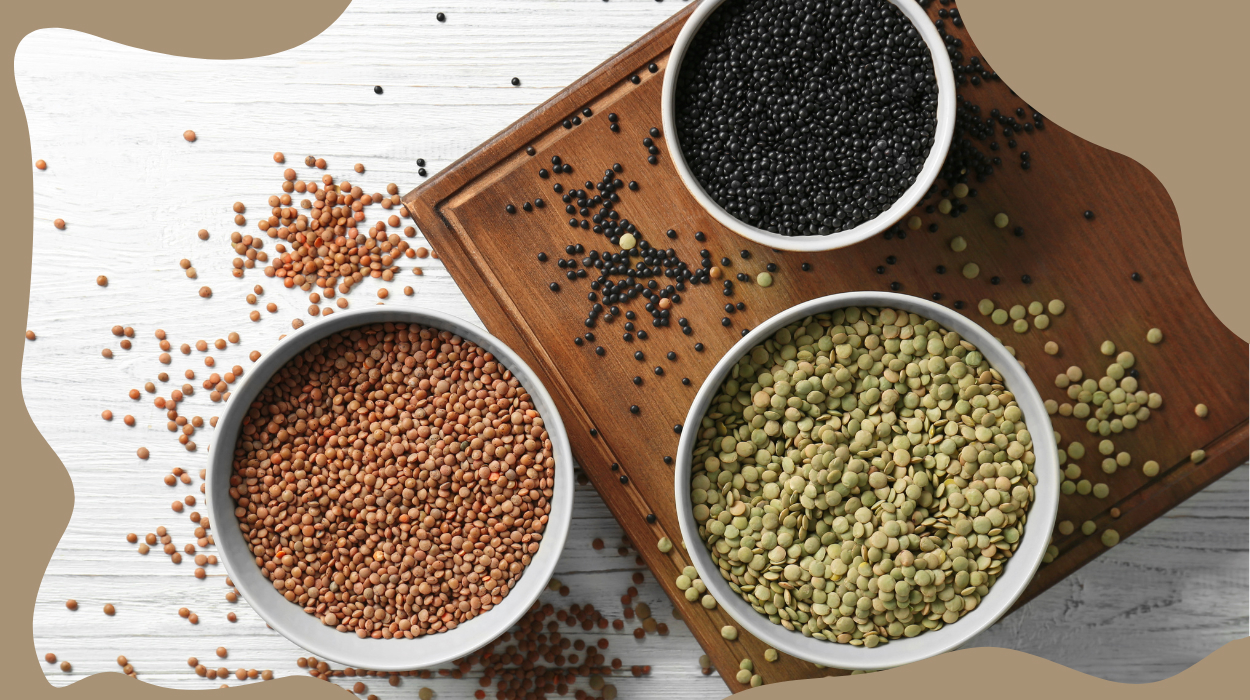 Evidence Based
Evidence Based
Evidence Based
This article is objectively based on relevant scientific literature, written by experienced medical writers, and fact-checked by a team of degreed medical experts.
Our team of registered dietitian nutritionists and licensed medical professionals seek to remain objective and unbiased while preserving the integrity of any scientific debate.
The articles contain evidence-based references from approved scientific sites. The numbers* in parentheses (*1,2,3) will take you to clickable links to our reputable sources.
Are Lentils Gluten Free? What You Need To Know In 2024

Lentils, a small but nutritionally mighty member of the legume family, are a staple in many diets worldwide. Known for their versatility and high protein content, lentils are commonly used in various dishes. Besides being one of the foods highest in zinc, they offer many health benefits and are essential for a balanced diet.
However, as the awareness of dietary restrictions like gluten intolerance is rising, it is natural to question how these legumes fit into such diets. Thus, you might be asking, “Are lentils gluten-free?” Here, we will answer that crucial question and explore what everyone needs to know about lentils.
Do Lentils Have Gluten?
Lentils do not have gluten in them. They are a legume that is planted and harvested. Gluten is often found in wheat, barley, and rye. However, manufacturing processes may introduce gluten into the lentils through cross-contamination.
Are All Types Of Lentils Gluten Free?
Gluten[1] is a family of proteins found primarily in grains, such as wheat, barley, and rye. The term gluten encompasses two main proteins, glutenin and gliadin. These proteins make gluten unique. Some individuals may be sensitive to gluten or may be affected by celiac disease, an autoimmune disorder triggered by consuming this protein.
However, are lentils a grain? They are not. Instead, they are legumes — meaning they are a naturally gluten-free food.
What Are Lentils?
Lentils are edible legumes in the same family as beans, peas, and chickpeas. They are small, lens-shaped seeds. They also come in various colors, including green, brown, black, and red.
Lentils are a staple food in many cuisines worldwide, particularly in South Asia, the Middle East, and Mediterranean regions. Their popularity has spread primarily due to their versatility, taste, and high nutritional value.[2]
Lentils are a naturally gluten-free food. They are an excellent source of plant-based protein,[3] dietary fiber, complex carbohydrates, vitamins, and minerals. They are low in fat[4] and contain no cholesterol. Lentils are also rich in folate, iron, potassium, and magnesium.
Different Types Of Lentils
There are several types of lentils. Each comes with unique taste, texture, and cooking times. Here’s a quick rundown:
- Green or Brown Lentils: These are the most widely available and are often used in various dishes. They have a mild flavor, hold their shape well during cooking, and have a slightly earthy taste. Green or brown lentils are suitable for soups, stews, salads, and side dishes.
- Red Lentils: Red lentils are popular in Indian, Middle Eastern, and Mediterranean cuisines. They are smaller and cook faster than green or brown lentils. When cooked, red lentils turn golden and soft and have a slightly sweet and nutty flavor. They are commonly used in dals, curries, soups, and purees.
- French Green Lentils (Puy Lentils): Puy lentils are small, dark green lentils that originated in the French region of Le Puy. They have a robust, peppery flavor and a firm texture even after cooking. Puy lentils hold their shape well and are often used in salads, warm side dishes, and lentil-based casseroles.
- Black Lentils (Beluga Lentils): Black lentils are also known as beluga lentils due to their resemblance to caviar. They are small and shiny with a rich flavor. They hold their shape when cooked and have a slightly nutty taste. Black lentils are often used in salads, side dishes, and soups.
- Yellow Lentils (Split Yellow Peas): While technically not lentils, split yellow peas are often included in the lentil category. They are dried and split legumes that cook quickly and become soft and mushy when cooked. Yellow lentils are commonly used in Indian cuisine for dals, soups, and curries.
How To Know If Lentils Are Gluten-Free
It’s important to ensure they are gluten-free when purchasing lentils or lentil products. Here are a few ways to determine if lentils are gluten-free:
- Read the label: Check the packaging for any indications of gluten-containing ingredients. Look for statements such as gluten-free or certified gluten-free on the packaging, ensuring that the lentils have been tested and meet certification standards by a gluten-free certification organization; and that there has been no potential for gluten cross-contamination from other gluten-containing products.
- Look for certifications: Some manufacturers voluntarily certify their lentils as gluten-free. Look for logos or certifications from recognized gluten-free organizations or agencies, such as the Gluten-Free Certification Organization,[5] a gluten-free watchdog, or similar entities. These certifications indicate that the lentils have undergone testing and have met strict gluten-free standards.
- Contact the manufacturer or supplier: If the packaging doesn’t provide clear information about errant gluten-containing grains, you can contact the manufacturer or supplier directly. Inquire about their manufacturing processes, cross-contamination, and whether they test for gluten. They should be able to provide the necessary information to determine if the lentils are gluten-free.
- Choose whole lentils: Opting for whole, unprocessed lentils instead of pre-packaged ones can reduce the risk of gluten contamination. Whole lentils not processed or packaged with other ingredients are less likely to contain gluten.
How To Add Lentils To Your Gluten-Free Diet
Adding lentils to a gluten-free diet plan provides a nutritious source of protein, fiber, and other essential nutrients. Here are some ways to add lentils or other gluten-free products to your diet:
- Cook from scratch: Purchase dried lentils or other suitable dried beans from a reputable source and cook them at home. Rinse the beans thoroughly, then simmer them in water or broth until they become tender. Cooked beans or lentils can be used in various dishes like soups, stews, curries, salads, or as a side dish.
- Use lentil flour: Lentil flour, made from ground lentils, can be a gluten-free alternative to wheat flour. It can be used in baking recipes, such as pancakes, bread, or muffins, to add nutritional value and a unique flavor.
- Explore lentil-based products: Look for gluten-free lentil-based products, such as lentil pasta or lentil chips, available in many health food stores. These products provide gluten-free options for pasta dishes, lentil salad, lentil soup, or snacking.
- Incorporate lentil protein powders: Lentil protein powders are gluten-free and can be added to smoothies or used as a protein supplement. They are a convenient way to increase your protein intake while avoiding gluten.
- Meal delivery services: Consider using gluten-free meal delivery services that offer lentil-based meals. These services provide gluten-free pre-prepared meals, including options with lentils as a main ingredient.
- Avoid processed lentil products: While lentil-based products can be convenient, be cautious with processed lentil products like meal replacement bars or fat burners, as they may contain additives or other ingredients that could contain gluten. Always read the ingredient labels carefully or choose certified gluten-free options.
Some Gluten-Free Legume Alternatives To Lentils
If you’re looking for gluten-free legume alternatives to lentils, several options exist. Here are some gluten-free legumes that you can incorporate into your diet:
- Chickpeas: Chickpeas, also known as garbanzo beans, are a versatile and popular gluten-free legume. They can be used in various dishes, such as hummus, salads, curries, and stews. Chickpea flour is also a great gluten-free option for baking and cooking.
- Black Beans: Black beans are another gluten-free legume that can be used in a variety of recipes. They have a slightly sweet and earthy flavor and can be included in soups, salads, burritos, and side dishes. Black bean flour is also available as a gluten-free alternative for baking.
- Kidney Beans: Kidney beans are a common gluten-free legume that works well in chili, salads, and bean-based dishes. They have a rich, hearty flavor and a firm texture. Kidney bean flour can also be used as a gluten-free flour substitute.
Conclusion
Adopting a gluten-free diet doesn’t mean sacrificing nutritional quality or variety. Indeed, lentils are an excellent addition to a gluten-free dining regimen with their rich nutrient profile and versatility in numerous dishes.
Frequently Asked Question
No, lentils do not contain gluten. They are legume plants. The only way gluten is introduced s through the manufacturing process.
Lentils are naturally gluten-free and suitable for people with gluten intolerance.
Lentils are naturally gluten-free, but cross-contamination may occur during processing or cooking.
Lentil flour is gluten-free, but check the packaging for possible cross-contamination.
Alternatives can include other gluten-free legumes like chickpeas, navy beans, lima beans, fava beans, or peas.
+ 5 sources
Health Canal avoids using tertiary references. We have strict sourcing guidelines and rely on peer-reviewed studies, academic researches from medical associations and institutions. To ensure the accuracy of articles in Health Canal, you can read more about the editorial process here
- Biesiekierski, J.R. (2017). What is gluten? [online] 32, pp.78–81. doi:https://doi.org/10.1111/jgh.13703.
- Marcel Skejovic Joehnke, Jeske, S., Lilit Ispiryan, Zannini, E., Arendt, E.K., Bez, J., Jens Nørkær Sørensen and Iben Lykke Petersen (2021). Nutritional and anti-nutritional properties of lentil (Lens culinaris) protein isolates prepared by pilot-scale processing. [online] 9, pp.100112–100112. doi:https://doi.org/10.1016/j.fochx.2020.100112.
- Ganesan, K. and Xu, B. (2017). Polyphenol-Rich Lentils and Their Health Promoting Effects. [online] 18(11), pp.2390–2390. doi:https://doi.org/10.3390/ijms18112390.
- Wilson, S.R., Peterson, E.A., Gaston, M., Kuo, W.-Y. and Miles, M.P. (2022). Eight weeks of lentil consumption attenuates insulin resistance progression without increased gastrointestinal symptom severity: A randomized clinical trial. [online] 106, pp.12–23. doi:https://doi.org/10.1016/j.nutres.2022.08.002.
- Gluten-Free Certification Organization. (2020). About Us – Gluten-Free Certification Organization. [online] Available at: https://gfco.org/about-us/



